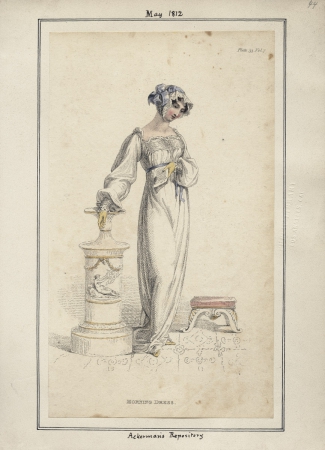
Getting dressed during the Regency occupied much of a lady’s time, mostly because she had to do it so frequently every day. When a lady of wealth and quality arose, she usually threw on a dressing gown over her shift or her nightgown (also referred to as a night rail), whichever she preferred for sleeping.
After breaking her fast with a light meal which often included chocolate (hot, usually no cream or sugar), fruit and/or some kind of bread such as a croissant that her maid brought to her on a tray, she would then perform her morning toilette routine, have her maid do her hair, and so forth. After that, she dressed in a morning gown. This was also known as undress. The term “undress” does not mean one is not wearing clothes, simply that one is not dressed to go out. Dishabille is another term for undress. Morning gowns were generally made of simpler fabrics and more loose-fitting styles. Ladies might wear morning gowns all day since they were appropriate for a day at home up until dinner.
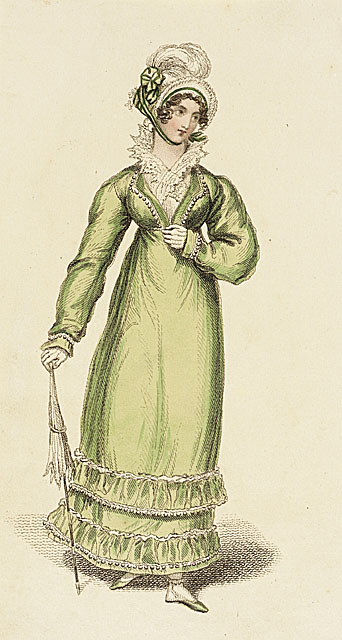
She then went downstairs for breakfast with the family, which was served buffet style. She might while away the morning painting or doing needlework or some kind of craft such as gluing shells on lamps or picture frames, or gluing feathers or flowers on hats. If she were the lady of the home, she might meet with the head housekeeper, make plans, catch up on her correspondence.
If a fashionable lady went for a “brisk constitutional” she donned a walking gown, also known as a redingote or a pelisse. This protected the delicate fabrics and pastel colors of her gown and also could provide warmth if necessary. Sturdy walking shoes which were often nankeen half boots went along with the ensemble.
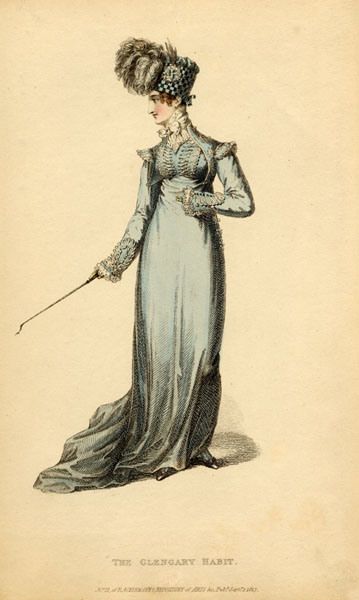
For going horseback riding (a lady always rode aside–side-saddle–unless she wanted to cause a scandal or admit she was an inept horsewoman), ladies changed into a riding habit. The riding habit included a long train to aid in keeping her legs covered. It was also fashionable and proclaimed her wealth and status. This ensemble always included a hat, riding gloves, and riding boots as well as a riding crop. Incidentally, the most fashionable riding habits were made by a tailor, rather than a dressmaker. Some ladies reportedly wore riding breeches underneath their riding habits. Whether this was for additional preservation of modesty or for comfort against chaffing, I do not know.

A trip required a different costume. When a lady took a journey via carriage, she often changed into carriage dress which included a practical gown (practical being a relative term during the Regency upper class) and a pelisse to protect her clothing from the dust and dirt of carriage travel.
For those afternoon visits when a lady planned to call upon nearby friends and neighbors and perhaps enjoy some tea or go strolling in the park a during the fashionable hour, she would change into a “half dress” or an afternoon gown, also known as Promenade dress. Depending on the weather, she would wear a shawl or a spencer or a pelisse as well as a hat, gloves, and slippers.
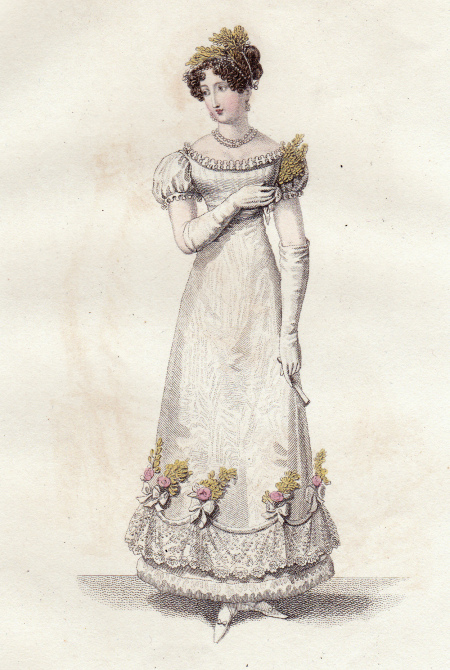
Evening required another change. To dinner, one wore an evening gown, whether eating home with family or with friends. Dinner among the nobility was always a formal affair with the best dress, more elaborate coiffures, and best manners. In today’s terms, it would be considered Black Tie or semi-formal. Ladies might wear understated jewelry, usually diamonds or pearls. If one were unwell and unable to join the family for dinner, one might take a tray in one’s room.
A ball or soiree or trip to the opera called for a full formal dress, what today would be known as “white tie” affair. Gowns appropriate for Full Dress frequently came with trains, Early in the Regency, ballgowns had trains, although I cannot imagine how one could be expected to perform those vigorous Regency dances with a train on one’s gown. Some period ball gowns have buttons and loops used for pinning up her gown so that may have been a common solution. I have found no ballgowns with trains after the year 1815 so they seemed to have fallen out of fashion by then. If one expected to dance during the course of the evening, a lady brought along dancing slippers which had such thin soles that they were too delicate to wear anywhere but the ballroom. Jewels such as tiaras, necklaces, earrings, bracelets etc. were more likely to be displaced during formal dress occasions than any other.
Court dress, the required clothing for taking bows to the queen, had its own set of standards, including the number of feathers required and, in the early part of the 19th century, even a hoop skirt, which, with the empire waistline, was a fashion disaster. When designing a court dress, one had to check the requirements for that specific year as they changed frequently.
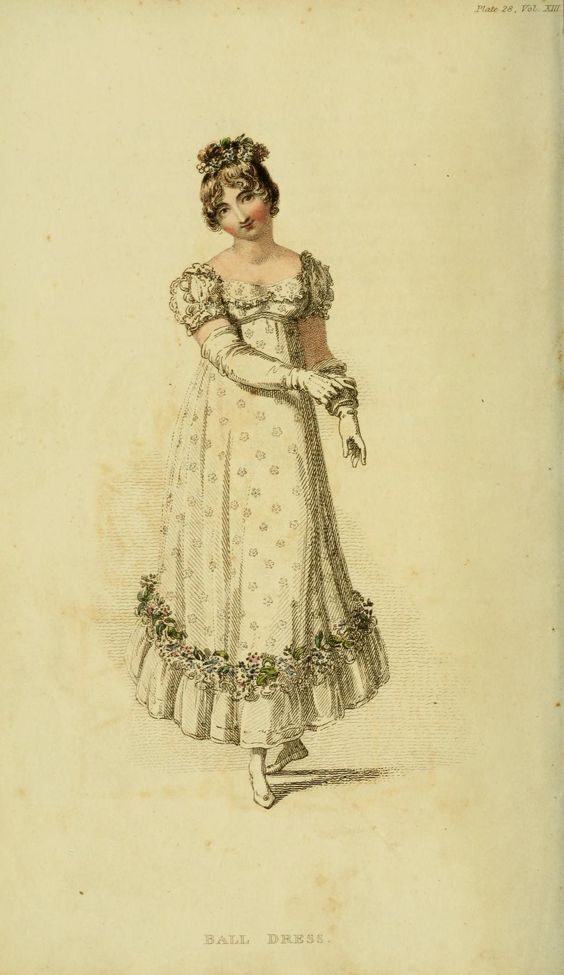
Of course, each change of clothing required a change of accessories including shoes, gloves, and hat or other headwear. Evening wear also demanded a change of hairstyle to something more formal and intricate.
Can you imagine changing your clothes that many times every day? No wonder they needed a lady’s maid to assist with all of the fuss!

Operas were always full-dress affairs–definitely no “semi” to the formal. Diamonds and pearls could only be worn with full dress by a lady of taste, quite unlike today when pearls are a frequent sight for casual daywear.
Ball gowns frequently had trains; these could be pinned up for dancing or simply held in one’s hand. As waltzing was not yet a custom and any dances would be quadrilles or other set dances, it would be quite easy to hold it in an unoccupied hand. Austen mentions friends pinning up one another’s trains for dancing in Northanger Abbey.
Thank you for the wonderful explanations! It’s very confusing and hard to keep track of or visualize when reading! This was so interesting.
I am confused about the pelisse, however. First you said a walking gown was also known as a pelisse, but then a trip required a carriage dress … AND a pelisse. Two dresses?
Carriage dress refers to the entire ensemble, or outfit, if you will. The pelisse is part of that ensemble and is worn over the gown. Does that clear it up?
You pinned up the train on your evening gown by lifting it at the waist seam at the back. More likely your maid or friend did it.
Good point! Thanks for commenting. 🙂